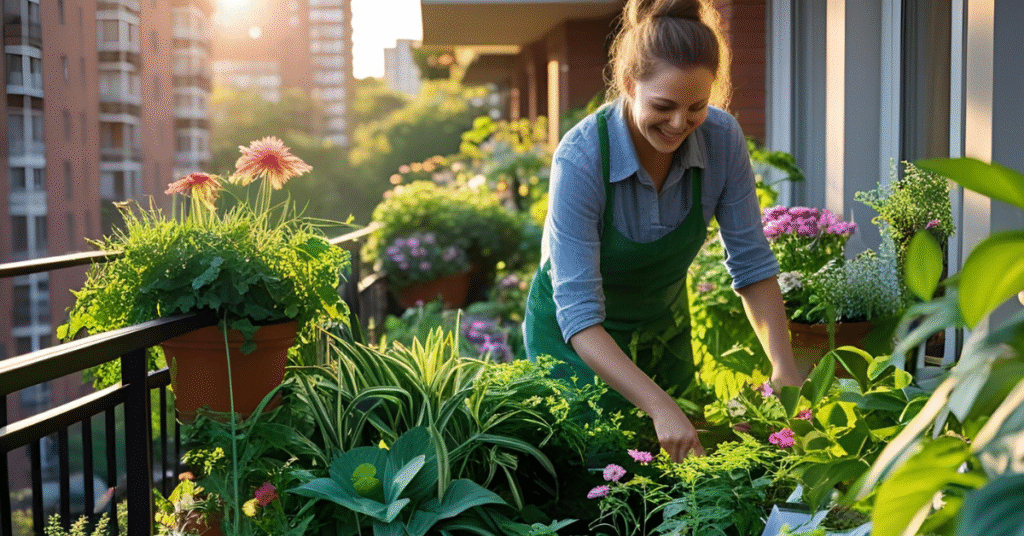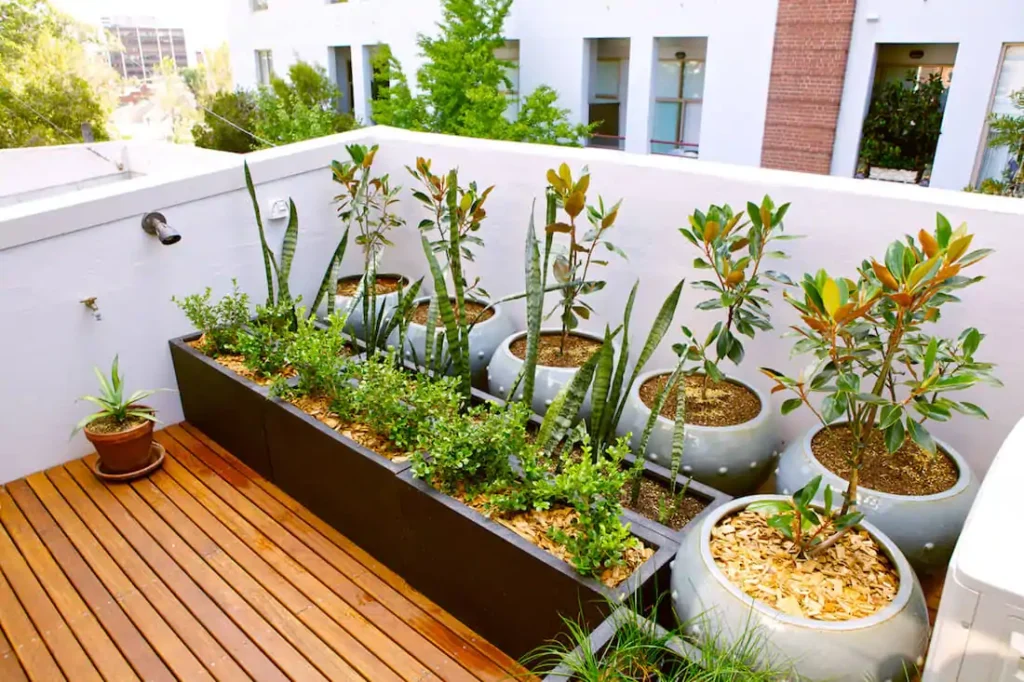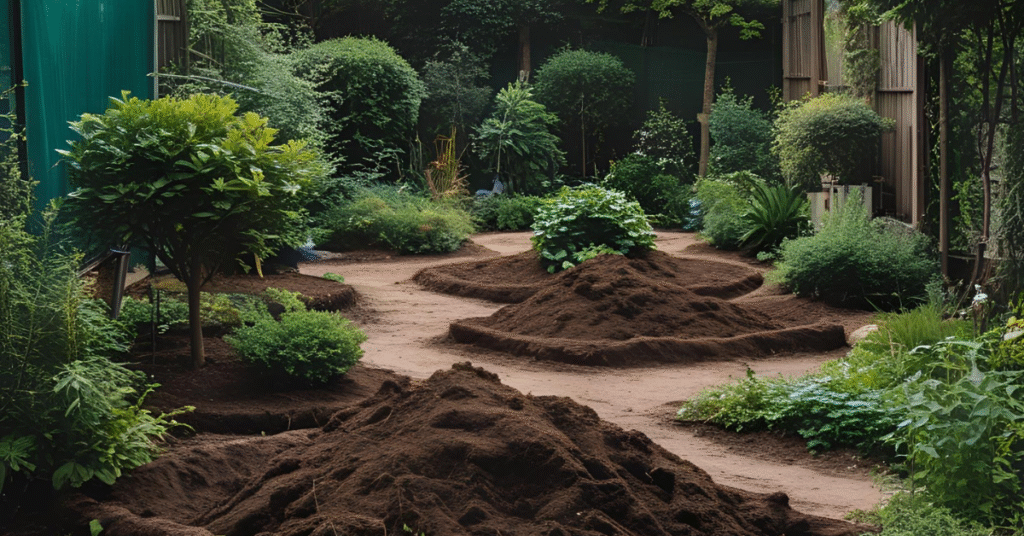Starting your gardening journey can feel overwhelming, especially when faced with endless tool options. However, the essential tools every new gardener needs are surprisingly straightforward and manageable for any budget. This comprehensive guide will walk you through exactly what you need to get started, why each tool matters, and how to choose quality equipment that will serve you for years to come.
Quick Start Tip
Don’t feel pressured to buy everything at once. Start with the top 5 essential tools every new gardener needs: hand trowel, pruning shears, garden gloves, watering can, and a small spade. You can always expand your collection as your garden grows.
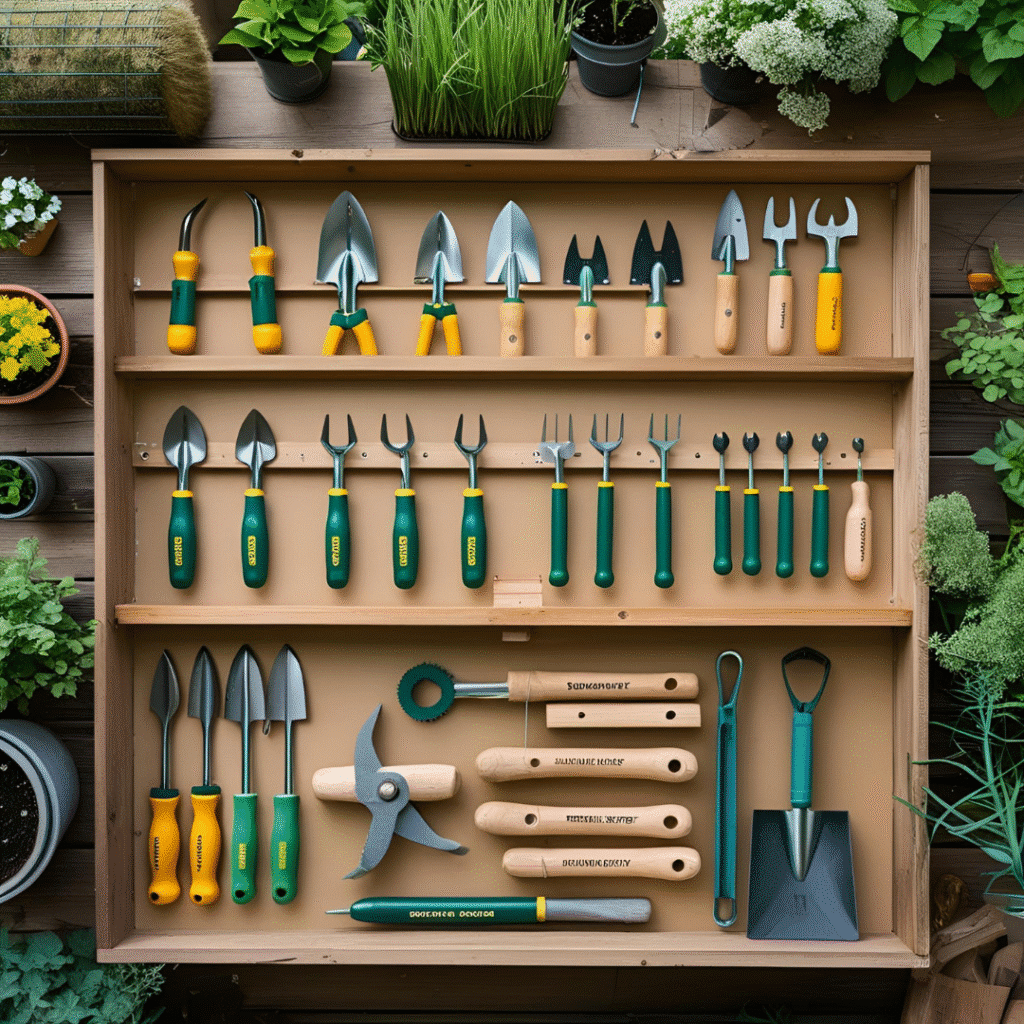

Why Having the Right Essential Tools Makes All the Difference
Saves Time
The right tools can cut your gardening time in half, making tasks more efficient and enjoyable.
Prevents Injury
Quality tools reduce strain on your body and prevent common gardening injuries.
Better Results
Proper tools lead to healthier plants and more successful gardening outcomes.
Research shows that new gardeners who invest in quality basic tools are 3x more likely to continue gardening after their first season. The essential tools every new gardener needs serve as the foundation for developing proper techniques and building confidence in your gardening abilities.
Essential Hand Tools Every New Gardener Needs
Hand Trowel
The most versatile tool in your arsenal. Perfect for planting, transplanting, and weeding in small spaces.
Key Features to Look For:
- Stainless steel blade for durability
- Comfortable, non-slip grip
- Blade width: 2-3 inches for versatility
- Measurement markings helpful for planting depth
Pro Tip: A narrow blade cuts through roots better, while a wider blade moves more soil efficiently.
Garden Gloves
Protect your hands from thorns, splinters, and soil while maintaining dexterity for detailed work.
Essential Features:
- Breathable, flexible material
- Reinforced fingertips and palms
- Snug fit without being restrictive
- Water-resistant coating
Size Matters: Gloves should fit snugly but allow finger movement. Too loose leads to blisters, too tight restricts circulation.
Hand Cultivator/Fork
Perfect for breaking up soil, removing weeds, and aerating around plants without damaging roots.
Best Applications:
- Loosening compacted soil
- Mixing in compost or fertilizer
- Weeding between plants
- Aerating container gardens
Quality Check: Look for tines that won’t bend under pressure and a comfortable grip that reduces hand fatigue.
Hand Weeder
Specialized tool for removing weeds with their roots intact, preventing regrowth.
Types Available:
- Dandelion weeder (long, narrow blade)
- Fishtail weeder (forked end)
- Cape Cod weeder (L-shaped blade)
- Hori-hori knife (multi-purpose)
Technique Tip: Water the area first to soften soil, making weed removal easier and more complete.
Hand Tools Investment Guide
Budget Option ($30-50)
Basic set with essential hand tools. Good for starting out and testing your gardening interest.
Mid-Range ($50-100)
Better materials and ergonomic designs. Ideal for regular gardening activities.
Professional-grade tools with lifetime warranties. Worth it for serious gardeners.
Long-Handled Tools: Essential Equipment for Efficient Gardening
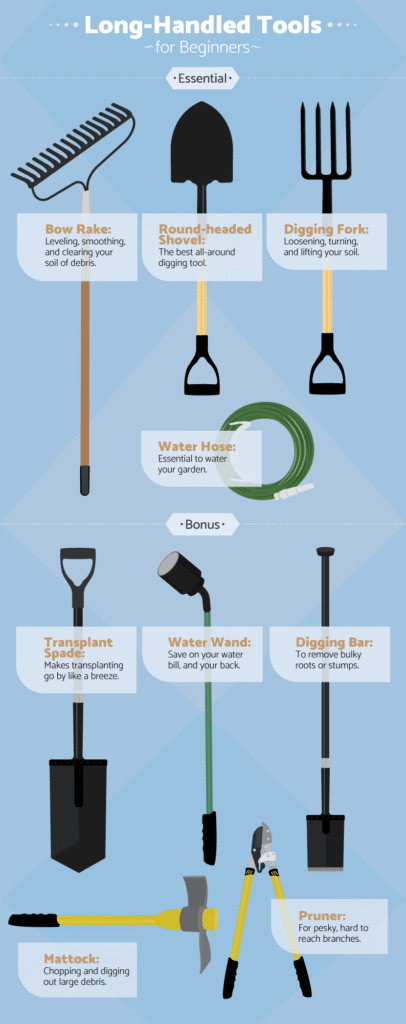
Garden Spade
The backbone of digging tasks. Essential for creating clean edges, digging planting holes, and moving soil.
Key Specifications:
- Blade: 7-8 inches wide, flat edge
- Handle: 28-30 inches for leverage
- Material: Stainless steel or carbon steel
- Weight: 2-3 pounds for maneuverability
Spade vs Shovel: Spades have flat blades for cutting, shovels have curved blades for scooping.
Garden Fork
Excellent for breaking up compacted soil, turning compost, and working with rocky terrain.
Design Features:
- 4 square tines for strength
- Tine length: 6-8 inches
- Ash or fiberglass handle
- D-grip for better control
Soil Tip: Forks work better than spades in clay soil and won’t damage bulbs or root vegetables.
Garden Rake
Smooths soil, removes debris, and creates the perfect seedbed for planting.
Two Main Types:
- Bow rake: Metal tines for soil work
- Leaf rake: Flexible tines for debris
- Adjustable rakes: Versatile option
- Width: 12-16 inches for efficiency
Technique: Use a push-pull motion to level soil and create smooth planting surfaces.
Garden Hoe
Cultivates soil, cuts weeds, and creates furrows for planting rows.
Popular Varieties:
- Draw hoe: Traditional chopping action
- Stirrup hoe: Push-pull weeding
- Wheel hoe: Easier on the back
- Blade width: 4-6 inches standard
Sharpening: Keep hoe blades sharp for effective weed cutting with minimal effort.
Choosing the Right Handle Length
Short Handles (24-28 inches)
Better control and precision. Ideal for detailed work and smaller gardeners.
Long Handles (30-36 inches)
More leverage and less bending. Better for taller gardeners and heavy digging.
Watering Equipment: Essential Tools Every New Gardener Needs for Plant Health
Watering Can
Provides gentle, controlled watering perfect for seedlings and delicate plants.
Essential Features:
- Capacity: 1-2 gallons for balance
- Removable rose (sprinkler head)
- Balanced handle design
- Durable metal or BPA-free plastic
Sizing Guide: Consider your strength – a gallon of water weighs 8 pounds!
Watering Wand
Extends your reach for hanging baskets and provides gentle shower-like watering.
Advantages:
- Reduces bending and stretching
- Gentle water breaking action
- Shut-off valve at handle
- Various lengths available
Length Guide: 18-24 inches for most gardens, 30+ inches for hanging baskets.
Garden Hose
Reaches all areas of your garden with adjustable water pressure and flow.
Key Specifications:
- Diameter: 5/8 inch for good flow
- Length: 50-100 feet typical
- Material: Rubber over vinyl
- Brass fittings for durability
Storage Tip: Drain and coil properly to prevent kinks and extend lifespan.
Sprinkler System
Automates watering for larger areas and ensures consistent moisture levels.
Types to Consider:
- Oscillating: Good for rectangles
- Rotary: Circular coverage
- Drip irrigation: Water-efficient
- Soaker hoses: Root-zone watering
Water Wisdom: Water deeply but less frequently to encourage deep root growth.
Watering Best Practices for New Gardeners
Timing
- Early morning (6-8 AM) is ideal
- Evening watering is second best
- Avoid midday watering (water loss)
- Consider weather and season
Technique
- Water at soil level, not leaves
- Deep, infrequent watering
- Check soil moisture first
- Adjust for plant needs
Cutting & Pruning Tools: Essential Equipment for Plant Health
Pruning Shears (Secateurs)
The most essential cutting tool for trimming, shaping, and harvesting in your garden.
Types Available:
- Bypass pruners: Clean cuts on live wood
- Anvil pruners: Best for dead wood
- Ratchet pruners: Easier for weak grip
- Capacity: Up to 3/4 inch diameter
Quality Matters: Sharp, clean cuts prevent disease and promote faster healing.
Loppers
Long-handled cutting tools for thicker branches and hard-to-reach areas.
Key Features:
- Handle length: 18-32 inches
- Cutting capacity: 1-2 inches
- Gear or compound action available
- Lightweight materials preferred
Leverage Law: Longer handles provide more cutting power but can be heavier to manage.
Garden Scissors
Precision cutting for delicate tasks like deadheading and herb harvesting.
Best Uses:
- Deadheading flowers
- Harvesting herbs and vegetables
- Cutting twine and plant ties
- Trimming small, soft growth
Precision Tool: Choose scissors with fine, sharp blades for clean cuts without crushing stems.
Pruning Saw
For branches too thick for loppers, typically 2+ inches in diameter.
Types to Consider:
- Folding saw: Portable and safe
- Straight saw: More cutting power
- Curved saw: Natural cutting motion
- Blade length: 6-10 inches typical
Safety First: Always cut branches in sections and be aware of branch tension and falling direction.
Cutting Tool Maintenance Schedule
After Each Use
- Clean blades with soapy water
- Dry thoroughly
- Apply light oil to prevent rust
Monthly
- Sharpen blades as needed
- Check for loose screws
- Lubricate moving parts
Seasonally
- Deep clean and service
- Replace worn parts
- Store properly for winter
Complete Buying Guide: Essential Tools Every New Gardener Needs
Quality Indicators to Look For
Material Quality
- Stainless steel or carbon steel blades
- Hardwood or fiberglass handles
- Rust-resistant coatings
- Solid construction without gaps
Ergonomic Features
- Comfortable grip size
- Non-slip handle coating
- Balanced weight distribution
- Reduced vibration design
Budget Planning
Starter Kit ($75-150)
- Hand trowel, pruning shears, gloves
- Watering can, small spade
- Basic quality, good for beginners
Complete Set ($200-400)
- All essential tools covered
- Mid-range quality materials
- Suitable for regular gardening
Professional Grade ($400+)
- Premium materials and construction
- Lifetime warranties available
- Worth it for serious gardeners
Where to Buy Essential Tools Every New Gardener Needs
Local Garden Centers
Expert advice, hands-on testing, often carry quality regional brands.
Home Improvement Stores
Wide selection, competitive prices, seasonal sales available.
Online Retailers
Convenient shopping, reviews, often better prices but no hands-on testing.
Tool Prioritization for New Gardeners
Buy First (Essential)
- Hand trowel
- Pruning shears
- Garden gloves
- Watering can
Buy Second (Important)
- Garden spade
- Garden rake
- Hand cultivator
- Garden hose
Buy Later (Nice to Have)
- Wheelbarrow
- Loppers
- Garden fork
- Specialized tools
Tool Maintenance: Keeping Your Essential Gardening Tools in Peak Condition
Daily Maintenance
After Each Use
- Remove soil and debris
- Wipe blades clean
- Check for damage
- Store in dry location
Quick Cleaning
- Use brush or cloth
- Spray with water if needed
- Dry thoroughly
- Apply light oil to metal
Deep Cleaning
Monthly Deep Clean
- Soak in warm soapy water
- Scrub with steel wool
- Remove rust with sandpaper
- Oil all moving parts
Seasonal Service
- Sharpen all blades
- Replace worn handles
- Tighten loose connections
- Apply protective coating
Tools That Need Sharpening
- Pruning shears and loppers
- Spades and shovels
- Hoes and cultivators
- Garden knives
- File: Most common method
- Sharpening stone: For precision
- Professional service: For complex tools
- Always maintain original angle
Storage Solutions
Tool Shed
Ideal for protecting tools from weather. Include hooks, shelves, and proper ventilation.
Garage Storage
Wall-mounted systems save space. Keep tools off the floor to prevent rust.
Outdoor Storage
Weatherproof containers work for smaller tools. Ensure good drainage.
Seasonal Tool Needs: Using Essential Tools Throughout the Year
Spring & Summer
Priority Tools
- Hand trowel for planting
- Watering equipment (high use)
- Pruning shears for maintenance
- Hoe for weed control
Key Activities
- Soil preparation and planting
- Regular watering and weeding
- Pruning and deadheading
- Harvesting vegetables
Fall & Winter
Priority Tools
- Rake for leaf cleanup
- Loppers for dormant pruning
- Spade for fall planting
- Pruning saw for tree work
Key Activities
- Leaf and debris removal
- Pruning dormant plants
- Preparing beds for winter
- Tool maintenance and storage
Year-Round Tool Care Calendar
Spring
- Inspect all tools
- Sharpen blades
- Replace worn parts
- Oil moving parts
Summer
- Clean after each use
- Check for wear
- Maintain cutting tools
- Store properly
Fall
- Deep clean all tools
- Repair any damage
- Apply rust protection
- Prepare for storage
Winter
- Store in dry location
- Check occasionally
- Plan replacements
- Research new tools
Frequently Asked Questions: Essential Tools Every New Gardener Needs
What are the most essential tools every new gardener needs to start with?
The top 5 essential tools every new gardener needs are: a hand trowel for planting and weeding, pruning shears for cutting and trimming, quality garden gloves for protection, a watering can for gentle plant care, and a garden spade for digging and soil preparation. These tools cover 80% of basic gardening tasks.
How much should I budget for essential gardening tools as a beginner?
For essential tools every new gardener needs, budget $75-150 for a basic starter set, $200-400 for a complete mid-range collection, or $400+ for professional-grade tools. Start with basic quality and upgrade as your gardening skills develop. Quality tools last longer and perform better than cheap alternatives.
What’s the difference between bypass and anvil pruning shears?
Bypass pruning shears have two curved blades that slide past each other like scissors, making clean cuts ideal for live, green wood. Anvil pruners have one sharp blade that cuts down onto a flat surface, better for dead wood but can crush living stems. For beginners, bypass pruners are more versatile.
How do I maintain my essential gardening tools?
Clean tools after each use, removing soil and debris. Dry thoroughly and apply light oil to metal parts. Monthly, sharpen blades as needed and lubricate moving parts. Seasonally, perform deep cleaning, replace worn parts, and properly store tools in a dry location to prevent rust.
Do I need different tools for container gardening vs. ground gardening?
The essential tools every new gardener needs remain largely the same, but container gardening emphasizes smaller hand tools. Focus on hand trowels, small cultivators, watering cans with narrow spouts, and compact pruning shears. Long-handled tools are less necessary for container gardens.
When is the best time to buy gardening tools?
The best time to buy essential gardening tools is during end-of-season sales (late fall/early winter) when retailers clear inventory. Spring offers the widest selection but higher prices. Black Friday and post-holiday sales often feature good deals on tool sets.
Should I buy tools individually or in sets?
For beginners, quality tool sets offer better value and ensure all essential tools work together. However, if you have specific needs or quality preferences, buying individual tools allows you to choose the best option for each task. Consider starting with a basic set and upgrading individual tools as needed.
Start Your Gardening Journey with Confidence
Having the right essential tools every new gardener needs is the foundation of successful gardening. Start with the basics – a quality hand trowel, pruning shears, garden gloves, watering can, and spade – then gradually expand your collection as your skills and garden grow.
Remember that investing in quality tools pays dividends in efficiency, durability, and gardening enjoyment. Proper maintenance will keep your tools performing well for years to come, making your gardening experience more productive and satisfying.
Key Takeaways
- Start with 5 essential tools: trowel, pruners, gloves, watering can, spade
- Invest in quality over quantity for better long-term value
- Regular maintenance extends tool life and performance
- Choose tools that fit your physical needs and garden size
Next Steps
- Visit local garden centers to test tools before buying
- Start with essential tools and expand gradually
- Learn proper techniques for each tool
- Join gardening communities for ongoing support
